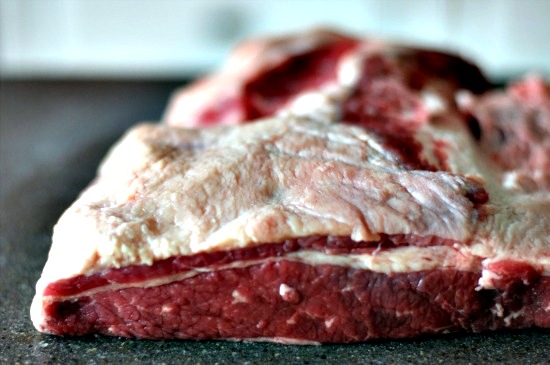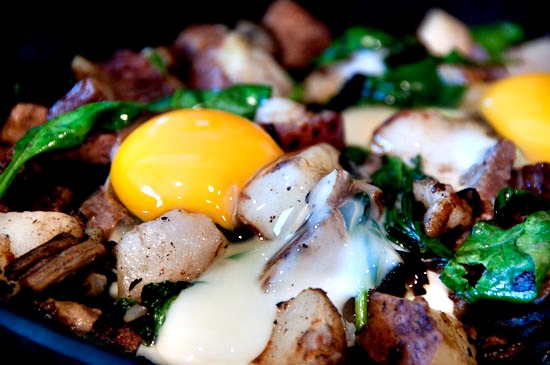This past month, Charcutepalooza was all about brining. Our fearless leaders in all things meat, Cathy and Kim, challenged us to make corned beef.
Corned beef is usually made with brisket, a cut of beef that comes from the breast/lower chest of the cow. Brisket contains lots of connective tissue, so proper preparation is essential if you want the meat to be tender (and if you eat meat, you definitely want it to be tender).
I’ve made brisket a bunch of times before. I always cook it the way I learned from my maternal grandma Bessie (I’ll call this “the Jewish way”). This means using deckle-on brisket (aka 2nd cut brisket), brisket that has not been trimmed/the fat is still attached (cooking the brisket with the layer of fat means there will be more flavor and less chance for the brisket to dry out…you can always trim it off after cooking) and smothering the brisket in a pretty sweet sauce. It is then cooked it in a tightly covered roasting pan at a low temperature for a long time. The result is indeed a very tender and delicious piece of meat, one that I often serve my family on Jewish holidays.
Corned beef, on the other hand, is made by soaking the brisket in a solution of water and salt (herbs, spices and some sugar are also often added) for a period of time – about 5 days – before you cook it. The salty liquid acts almost magically- see Ruhlman’sCharcuterie for a thorough explanation- to simultaneously dehydrate yet tenderize the meat. In addition, the long soak ensures a piece of meat infused throughout with the flavors of the brine. It’s a completely different approach to brisket, one that I truly came to appreciate with this challenge.
The brine for corned beef usually contains pink (aka curing) salt. For reasons I mentioned in my post about homemade bacon, I have committed to not using pink salt unless it is absolutely necessary for safety in the charcutepalooza challenges. I am not convinced that pink salt is harmless in the amounts used in most charcuterie recipes and I am far from the only one who feels this way. In the case of corned beef, pink salt plays a role in flavoring and lengthening the shelf life of the meat once cooked; it also contributes to the pink color of typical corned beef. It is not essential to the safety of the corned beef, so I chose to make mine without it.
I started with a five pound piece of untrimmed, organic, grass-fed, local brisket…
…and used this recipe from Saveur as my starting point. I followed the recipe more or less, but omitted the allspice and added 1 tablespoon fennel seeds, 1 tablespoon cumin seeds, 1/2 tablespoon juniper berries and 2 cinnamon sticks to the brine. I substituted dark muscovado sugar for the white sugar, and instead of using the pink salt, I cut a large beet in half and plopped it in the liquid (an idea I got from a twitter conversation with Lauren): my goal was to keep the meat from ending up an unappetizing grey, which I had been told might happen without the pink salt.
After five days of brining, a thorough rinsing, and 3 hours of boiling (I added an additional sliced beet to the boiling water along with the reserved spice mixture), my brisket was tender, with the perfect level of saltiness. It was also beautifully permeated with the herbs and spices from the brine. The flavors of the fennel and cumin were particularly prominent, so my corned beef, a dish most people associate with Irish-Americans, had and Indian-fusion “thing” going on. I really loved it.
I ate my first meal of the corned beef in “classic” (Irish) fashion (with potatoes and cabbage) but took no pictures (it was late and I was hungry…sorry). Then, with the leftovers, I made a quick and easy hash by combining 1 cup of chopped corned beef with 1/2 cup chopped red onion, 1 cup of chopped cooked potatoes, and a couple of handfuls of organic baby spinach in my cast-iron skillet.
When everything was nicely sauteed, I topped the hash off with a couple of eggs from my chickens, then let it finish cooking with the heat turned off and a cover on the pot. It was REALLY tasty, with no additional spices or salt needed: the corned beef has tons of flavor on its own.
Five pounds of corned beef is enough for lots of meals, so I also devoured a couple of Reuben sandwiches in the name of this challenge. I have not had a Reuben in many years, but I used to eat them when I was a kid with my grandpa Jack, a serious Jewish deli aficionado. It was nice to revisit this sandwich and think about my grandpa with each delicious bite.
To make mine, I used sourdough rye bread from Bread Alone, organic Swiss cheese, homemade sauerkraut (I make it a lot and already had some on hand), homemade Russian dressing (recipe from Charcuterie, and of course, my corned beef. ps I cooked my sandwich in my panini press to get those pretty grill marks.
All in all, this was a really fun challenge. To see what Cathy and Kim have in store for us ‘paloozers next month, check out this post.











